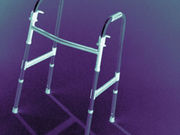No benefit on lower extremity function and increased risk of falls for higher monthly doses
TUESDAY, Jan. 5, 2016 (HealthDay News) — Higher monthly doses of vitamin D have no benefit on lower extremity function and correlate with increased risk of falls compared with lower doses in elderly adults, according to a study published online Jan. 4 in JAMA Internal Medicine.
Heike A. Bischoff-Ferrari, M.D., Dr.P.H., from the University Hospital Zurich, and colleagues examined the effectiveness of high-dose vitamin D in lowering the risk of functional decline in 200 community-dwelling men and women aged 70 years and older with a prior fall. Participants were allocated to three study groups with monthly treatments: 24,000 IU vitamin D3 (low-dose control group), 60,000 IU vitamin D3, and 24,000 IU vitamin D3 plus 300 µg calcifediol.
The researchers observed no significant difference between the groups in terms of improving lower extremity function (P = 0.26). The incidence of falls differed significantly between the groups over the 12-month follow-up, with higher incidences in the 60,000 IU group and the 24,000 IU plus calcifediol group versus the 24,000 IU group (66.9 and 66.1 percent, respectively, versus 47.9 percent; P = 0.048). The mean number of falls was higher for the 60,000 IU group and the 24,000 IU plus calcifediol group versus the 24,000 IU group (mean, 1.47 and 1.24, respectively, versus 0.94; P = 0.09).
“High monthly doses of vitamin D or a combination with calcifediol may not be warranted in seniors with a prior fall,” the authors write.
One author disclosed financial ties to pharmaceutical and nutrition companies, including Merck Sharp & Dohme, WILD, and DSM Nutritional Products, which funded the study.
Copyright © 2015 HealthDay. All rights reserved.








